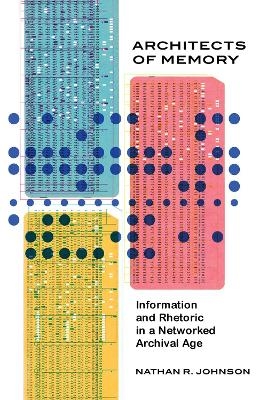
Architects of Memory
Information and Rhetoric in a Networked Archival Age
Seiten
2020
The University of Alabama Press (Verlag)
978-0-8173-2060-7 (ISBN)
The University of Alabama Press (Verlag)
978-0-8173-2060-7 (ISBN)
Probes the development of information management after World War II and its consequences for public memory and human agency. Nathan Johnson charts turning points where concepts of memory became durable in new computational technologies and modern memory infrastructures took hold.
Probes the development of information management after World War II and its consequences for public memory and human agency.
We are now living in the richest age of public memory. From museums and memorials to the vast digital infrastructure of the internet, access to the past is only a click away. Even so, the methods and technologies created by scientists, espionage agencies, and information management coders and programmers have drastically delimited the ways that communities across the globe remember and forget our wealth of retrievable knowledge.
In Architects of Memory: Information and Rhetoric in a Networked Archival Age, Nathan R. Johnson charts turning points where concepts of memory became durable in new computational technologies and modern memory infrastructures took hold. He works through both familiar and esoteric memory technologies- from the card catalog to the book cart to Zatocoding and keyword indexing - as he delineates histories of librarianship and information science and provides a working vocabulary for understanding rhetoric’s role in contemporary memory practices.
This volume draws upon the twin concepts of memory infrastructure and mnemonic technÊ to illuminate the seemingly opaque wall of mundane algorithmic techniques that determine what is worth remembering and what should be forgotten. Each chapter highlights a conflict in the development of twentieth-century librarianship and its rapidly evolving competitor, the discipline of information science. As these two disciplines progressed, they contributed practical techniques and technologies for making sense of explosive scientific advancement in the wake of World War II. Taming postwar science became part and parcel of practices and information technologies that undergird uncountable modern communication systems, including search engines, algorithms, and databases for nearly every national clearinghouse of the twenty-first century.
Probes the development of information management after World War II and its consequences for public memory and human agency.
We are now living in the richest age of public memory. From museums and memorials to the vast digital infrastructure of the internet, access to the past is only a click away. Even so, the methods and technologies created by scientists, espionage agencies, and information management coders and programmers have drastically delimited the ways that communities across the globe remember and forget our wealth of retrievable knowledge.
In Architects of Memory: Information and Rhetoric in a Networked Archival Age, Nathan R. Johnson charts turning points where concepts of memory became durable in new computational technologies and modern memory infrastructures took hold. He works through both familiar and esoteric memory technologies- from the card catalog to the book cart to Zatocoding and keyword indexing - as he delineates histories of librarianship and information science and provides a working vocabulary for understanding rhetoric’s role in contemporary memory practices.
This volume draws upon the twin concepts of memory infrastructure and mnemonic technÊ to illuminate the seemingly opaque wall of mundane algorithmic techniques that determine what is worth remembering and what should be forgotten. Each chapter highlights a conflict in the development of twentieth-century librarianship and its rapidly evolving competitor, the discipline of information science. As these two disciplines progressed, they contributed practical techniques and technologies for making sense of explosive scientific advancement in the wake of World War II. Taming postwar science became part and parcel of practices and information technologies that undergird uncountable modern communication systems, including search engines, algorithms, and databases for nearly every national clearinghouse of the twenty-first century.
Nathan R. Johnson is assistant professor of English at the University of South Florida. His work has appeared in the Journal of Technical Writing and Communication, Poroi, Journal of the Association for Information Science and Technology and enculturation: A Journal of Rhetoric, Writing, andCulture.
List of Figures
Acknowledgments
Introduction
Chapter 1. Building Memory's Infrastructure
Chapter 2. A Universal Memory Machine
Intermezzo: Exorcising the Library Spirit: Library Labor as a TechnÊ of Memory
Chapter 3. Hybrid Memory Labor
Intermezzo: Calvin Mooers's Zatocodes
Chapter 4. Memory Conflicts
Intermezzo: Dorothy Crosland's Book Truck
Chapter 5. Memory's Coin
Chapter 6. Memory's Infrastructure
Notes
References
Index
| Erscheinungsdatum | 06.07.2020 |
|---|---|
| Reihe/Serie | Alabama Rhetoric Culture and Social Critique Series |
| Zusatzinfo | 6 black & white figures |
| Verlagsort | Alabama |
| Sprache | englisch |
| Maße | 152 x 229 mm |
| Gewicht | 493 g |
| Themenwelt | Geisteswissenschaften ► Sprach- / Literaturwissenschaft ► Sprachwissenschaft |
| Mathematik / Informatik ► Informatik ► Theorie / Studium | |
| Sozialwissenschaften ► Kommunikation / Medien ► Buchhandel / Bibliothekswesen | |
| ISBN-10 | 0-8173-2060-1 / 0817320601 |
| ISBN-13 | 978-0-8173-2060-7 / 9780817320607 |
| Zustand | Neuware |
| Haben Sie eine Frage zum Produkt? |
Mehr entdecken
aus dem Bereich
aus dem Bereich
Das umfassende Standardwerk auf der Grundlage der aktuellen amtlichen …
Buch | Hardcover (2024)
Duden (Cornelsen Verlag)
35,00 €


